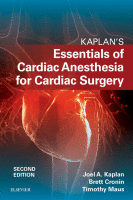Physical Address
304 North Cardinal St.
Dorchester Center, MA 02124

Key Points 1. Monitoring the effect of heparin is done using the activated coagulation time (ACT), a functional test of heparin anticoagulation. The ACT is susceptible to prolongation because of hypothermia and hemodilution and to reduction because of platelet activation…

Key Points 1. Electroencephalography can detect both cerebral ischemia or hypoxia and seizures and can measure hypnotic effect. 2. Middle-latency auditory-evoked potentials objectively document inadequate hypnosis. 3. Somatosensory-evoked potentials may detect developing injury in cortical and subcortical brain structures and…

Key Points 1. An ultrasound beam is a continuous or intermittent train of sound waves emitted by a transducer or wave generator that is composed of density or pressure. Ultrasound waves are characterized by their wavelength, frequency, and velocity. 2.…

Key Points 1. Patients with severe cardiovascular disease and those undergoing surgery associated with rapid hemodynamic changes should be adequately monitored at all times. 2. Standard monitoring for cardiac surgery patients includes invasive blood pressure, electrocardiography, central venous pressure, urine…

Key Points 1. The electrocardiogram reflects differences in transmembrane voltages in myocardial cells that occur during depolarization and repolarization within each cycle. 2. Processing of the electrocardiogram occurs in a series of steps. 3. Where and how electrocardiographic (ECG) electrodes…

Key Points 1. Ischemia during the perioperative period demands immediate attention by the anesthesiologist. 2. Nitroglycerin is indicated in most cases of perioperative myocardial ischemia. Mechanisms of action include coronary vasodilation and favorable alterations in preload and afterload. Nitroglycerin is…

Key Points 1. In patients, the observed acute effect of a specific anesthetic agent on the cardiovascular system represents the net effect on the myocardium, coronary blood flow (CBF), and vasculature; electrophysiologic behavior; and neurohormonal reflex function. Anesthetic agents within…

Key Points 1. The rapid development of molecular biologic and genetic techniques has greatly expanded the understanding of cardiac functioning, and these techniques are beginning to be applied clinically. 2. Cardiac ion channels form the machinery behind the cardiac rhythm;…

Key Points 1. To care for patients with coronary artery disease in the perioperative period safely, the clinician must understand how the coronary circulation functions in health and disease. 2. Coronary endothelium modulates myocardial blood flow by producing factors that…

Key Points 1. The cartilaginous skeleton, myocardial fiber orientation, valves, blood supply, and conduction system of the heart determine its mechanical capabilities and limitations. 2. The cardiac myocyte is engineered for contraction and relaxation, not protein synthesis. 3. The cardiac…